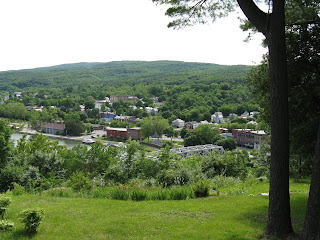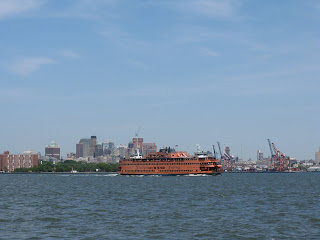As we moved North on the Lake it slowly began to widen. Soon we saw the stone walls of Fort Ticonderoga. I selected an anchorage east of the fort in wide bay next to Mt. Independence. After some lunch I unloaded the dinghy and headed for a beach I had sighted below and south of the fort. During an earlier call to the fort I was told there used to be a way to get to the fort from the water. She said look for a mowed area and a red roofed barn. I beached the dinghy, walked up the mowed slope, climbed about 80 steps, crawled over a locked gate and found myself almost at the front door of the ticket office. It took three hours to do a guided tour and go through all the museums. Most of the fort had been rebuilt since time and homeowners needing stone destroyed most of the stone work. The fort was important during the Revolution since after being captured from the British by xxx many of the cannon were used to supply artillery for battles further south.
After leaving the Fort Ticonderoga anchorage we moved up past other forts used by the French or British, Crown Point and Fort St. Fredric. We passed near the fort and went over to the waterfront of Port Henry. Port Henry is famous for iron and iron ore production which lasted until the early 70's. They claim iron that went into the construction of the ironclad Monitor of 1862 Civil War fame. We decided to move a little south into Bulwagga Bay. This was a quiet bay bordered on three sides and we anchored in about 9 feet of water which still had hydrilla growing in the bottom. The next morning, as we left Bulwagga Bay anchorage, there was an overcast sky and some cloud cover over the mountains (well maybe hills is more accurate) on the west side of the river. (see Picture) 
This picture shows some of the terrain of the west side of the lake.
After one day at Basin Harbor we headed north about 0745. A few miles north we found the shoaled entrance to Otter Creek and followed its winding path 8 miles down to the old Vermont town of Vergenes. Actually Vergennes claims the title of the oldest town in Vermont. We arrived there so early Saturday morning that we had no problem getting a spot at the public dock. After tying up we took a walk up the hill several blocks to the downtown. Lunch was at a cafe called Three Squares with an eclectic menu. You ordered off a chalk board with selections of five different breads and many condiments including sprouts. Pony tails, bicycle shorts and Birkenstock's were the uniform of the day for the locals. Before leaving the Lake Champlain Maritime Center, based on a recommendation from the Ticket Clerk who knew Vergennes, I had made a Saturday night reservation at Black Sheep Bistro and we enjoyed an excellent meal in downtown Vergennes. The picture shows the view of out boat from the top of the falls. We were tied up to a free public dock and even had a 50 amp hookup although I had to run the cord across an access road next to the bulkhead. We had a great view of the falls. That basin is where Captain MacDonough in 1812 built a fleet of ships to defend Lake Champlain against British invasion.
This is the view of the Vergennes Falls. As you would expect these falls were dammed to provide power for industry at the river. The small center building is actually a pump station built early in the 20th century to supply water to the fire fighting system in the town. During the second night we were there the town had a "Basin Bash" event and had a lighting of the falls as a finale. We watched as a rainbow of colors played on the rushing water.












































